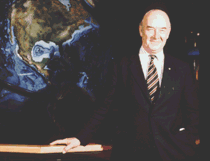

Canadian geophysicist J. Tuzo Wilson was also pivotal in advancing the plate-tectonics theory. Intrigued by Wegener's notion of a mobile Earth and influenced by Harry Hess' exciting ideas, Wilson was eager to convert others to the revolution brewing in the earth sciences in the early 1960s. Wilson had known Hess in the late 1930s, when he was studying for his doctorate at Princeton University, where Hess was a dynamic young lecturer.

J. Tuzo Wilson (1908-1993) made major contributions to the development of the plate-tectonics theory in the 1960s and 1970s. He remained a dominant force in the Canadian scientific scene until his death. (Photograph courtesy of the Ontario Science Centre.)
In 1963, Wilson developed a concept crucial to the plate-tectonics theory. He suggested that the Hawaiian and other volcanic island chains may have formed due to the movement of a plate over a stationary "hotspot" in the mantle. This hypothesis eliminated an apparent contradiction to the plate-tectonics theory -- the occurrence of active volcanoes located many thousands of kilometers from the nearest plate boundary. Hundreds of subsequent studies have proven Wilson right. However, in the early 1960s, his idea was considered so radical that his "hotspot" manuscript was rejected by all the major international scientific journals. This manuscript ultimately was published in 1963 in a relatively obscure publication, the Canadian Journal of Physics, and became a milestone in plate tectonics.
Another of Wilson's important contributions to the development of the plate-tectonics theory was published two years later. He proposed that there must be a third type of plate boundary to connect the oceanic ridges and trenches, which he noted can end abruptly and "transform" into major faults that slip horizontally. A well-known example of such a transform-fault boundary is the San Andreas Fault zone. Unlike ridges and trenches, transform faults offset the crust horizontally, without creating or destroying crust.
Wilson was a professor of geophysics at the University of Toronto from 1946 until 1974, when he retired from teaching and became the Director of the Ontario Science Centre. He was a tireless lecturer and traveller until his death in 1993. Like Hess, Wilson was able to see his concepts of hotspots and transform faults confirmed, as knowledge of the dynamics and seismicity of the ocean floor increased dramatically. Wilson and other scientists, including Robert Dietz, Harry Hess, Drummond Matthews, and Frederick Vine, were the principal architects in the early development of plate tectonics during the mid-1960s -- a theory that is as vibrant and exciting today as it was when it first began to evolve less than 30 years ago. Interestingly, Wilson was in his mid-fifties, at the peak of his scientific career, when he made his insightful contributions to the plate-tectonics theory. If Alfred Wegener had not died at age 50 in his scientific prime, the plate tectonics revolution may have begun sooner.